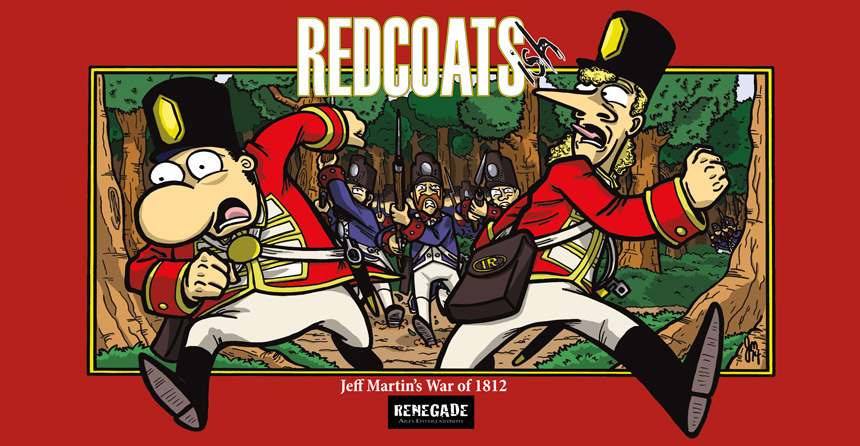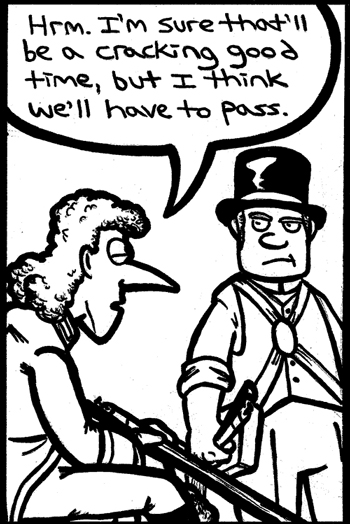| ________________
CM . . .
. Volume XXII Number 22. . . .February 12, 2016
excerpt:
Redcoats-ish began as a weekly webcomic published on Renegade Arts Entertainmentís website. Now collected, they present an interesting approach to describing the early part of the War of 1812, beginning with the declaration of war by the Americans in June, 1812, until the surrender of Fort Detroit by General Hull to Major General Isaac Brock on August 16, 1812. In this version of history, Martinís goal is to explore some lesser-known aspects of the war, such as the Battle of Maguaga, in a humorous way with cartoon characters whose comical incompetence is shared by all too many real figures from both sides of the war. Martin is interested in the thoughts and actions of the little guy, the non professional militiaman who may not have been very good at the job of soldiering. Well-known historic figures like Tecumseh, Brock, and Hull do make appearances, but their roles tend to be removed from the central focus of the tale, appearing more as cameos, much like the silent appearance of two of the Loxleys that readers may be acquainted with from the publisherís The Loxleys and the War of 1812.
While the militiamen are cartoonish, Martin includes lots of factual information in the comics. For example, he accurately depicts the American flag of the time as sporting fifteen stars and fifteen stripes, introduces some factual terms (Jonathan is slang for American, Long Knives is Indian slang for American, John Bull is American slang for British) and describes some real events and includes historically important figures. All soldiers show frustration with the work involved in loading their muskets before firing. The aboriginal allies of the British are depicted as wise and competent warriors who are also skilled at travelling undetected in the woods. A teaching guide authored by Martin is available for download via a link on the following page: www.renegadeartsentertainment.com/jeff martins war of 1812. It includes historical details and brief biographies of key figures along with discussion questions and a variety of classroom activities: Create a Comic Strip, Rewriting History, Create a Heritage History Minute, and, Create a Zine. With reference to the Alberta curriculum, Martin suggests that the volume can be used in grades 7 (social studies) as well as grades 11 and 12 history (American and Canadian history). In addition to history, the volume could be a supplementary work in the teaching of geography, social studies, visual arts, media literacy and aboriginal studies. Martinís teaching guide does not provide complete lesson plans, but it is a useful aid to help a teacher think of creative ways that this kind of book can be used as a learning resource. Recommended. Val Ken Lem is a librarian at Torontoís Ryerson University with liaison duties for history, English, and Caribbean studies.
To comment
on this title or this review, send mail to cm@umanitoba.ca.
Copyright © the Manitoba Library Association. Reproduction for personal
use is permitted only if this copyright notice is maintained. Any
other reproduction is prohibited without permission.
Next Review |
Table of Contents for This Issue
- February 12, 2016. |

 The book can be read as a humorous comic featuring the (mis)adventures of George Morton, a corpulent baker from Queenston, Upper Canada, prone to splitting his pants, who eagerly enlists with the militia and drags along his friend, John Pink, a fur trader who initially is a much more reluctant recruit. An early story line finds the two friends lost while on patrol and forced to engage with Americans on patrol who are not keen on warfare either. The militiaís Sergeant McGonagall also figures prominently and proves to be no less incompetent than George and John. Middle school boys in particular will enjoy the authorís sense of humour that includes references to split and soiled pants, fixation on eating, general silly behaviour and, on a more serious note, General Hullís cowardly hand wringing in Fort Detroit.
The book can be read as a humorous comic featuring the (mis)adventures of George Morton, a corpulent baker from Queenston, Upper Canada, prone to splitting his pants, who eagerly enlists with the militia and drags along his friend, John Pink, a fur trader who initially is a much more reluctant recruit. An early story line finds the two friends lost while on patrol and forced to engage with Americans on patrol who are not keen on warfare either. The militiaís Sergeant McGonagall also figures prominently and proves to be no less incompetent than George and John. Middle school boys in particular will enjoy the authorís sense of humour that includes references to split and soiled pants, fixation on eating, general silly behaviour and, on a more serious note, General Hullís cowardly hand wringing in Fort Detroit.